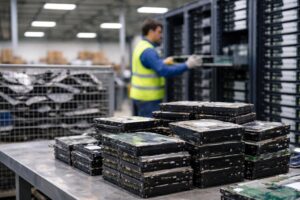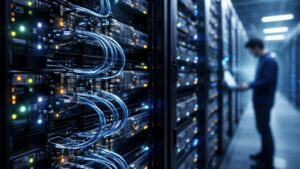Data centers are essential to the digital economy. However, their excessive energy consumption poses financial and environmental challenges. The tremendous electrical use of these gigantic buildings, which house thousands of servers, contributes greatly to the world’s carbon emissions. So, the IT sector is looking at innovative ways to cut energy use to solve this. One promising approach is serverless computing in data centers. Unlike traditional server models, serverless computing allows developers to upload individual functions that run in temporary containers.
By using resources only when needed and eliminating dedicated servers, serverless computing aims to optimize resource use and reduce idle capacity, potentially lowering energy consumption. However, the effects on energy efficiency are complex and need thorough analysis. In this article, we will do that analysis in-depth. So, let’s dive in.
Understanding Serverless Computing in Data Centers
Serverless computing affects how applications are designed and deployed. It provides a fresh approach to resource management. It is essentially distinct from conventional practices.
Traditional vs. Serverless Computing
In traditional setups, applications run on dedicated servers or virtual machines (VMs) managed by the organization. These servers often run continuously, leading to wasted resources when not in use. Organizations must predict peak loads and provision enough capacity, resulting in over-provisioning.
Serverless computing in data centers removes the need for dedicated servers or VMs. Applications are split into individual functions that run on demand in temporary containers. These containers start when needed and end after completing their tasks. This method scales resources dynamically based on demand. As a result, it reduces idle capacity and potentially saves energy. By not having servers running constantly, organizations can avoid the waste associated with over-provisioning.
The Serverless Computing Landscape
Serverless platforms like AWS Lambda, Google Cloud Functions, and Azure Functions have gained traction. Furthermore, developers upload code, and the platform manages resources. So, this simplifies development, allowing faster deployment. These platforms handle provisioning, scaling, and resource management. As a result, developers are freed from server management, focusing on core logic. This fosters quicker development cycles and innovation.
Energy Efficiency Considerations
While serverless computing in data centers aims to use resources efficiently and reduce idle capacity, its effect on overall energy use depends on several factors.
Resource Utilization and Idle Capacity
The primary benefit of serverless computing is its capacity to expand resources with demand. Furthermore, applications frequently operate on servers or virtual machines (VMs). They are more provisioned to accommodate peak demands in traditional server-based systems. So, when the load is low, this results in much-lost energy and idle capacity. Serverless computing allocates resources only when functions are invoked. This minimizes idle capacity and potentially saves energy.
However, serverless still relies on physical servers in data centers. The increase in energy efficiency in data centers is contingent upon the cloud provider’s ability to effectively manage resources. This is through the use of virtualization, workload scheduling, and container orchestration. Moreover, efficient management of these resources is essential. It helps to achieve the energy savings that serverless computing in data centers shows.
Cold Starts and Warm Containers
Serverless functions run in containers or lightweight runtime environments. The first time a function runs after being idle, it experiences a “cold start,” which involves creating a new container instance. This process can introduce latency and consume additional resources, potentially offsetting some of the energy efficiency gains. Cold starts require additional energy and time to spin up the necessary resources.
Subsequent runs within a certain time window use “warm containers,” where the existing instance is reused. This reduces the need for cold starts and can improve energy efficiency. By minimizing cold starts and optimizing the reuse of containers, serverless platforms can enhance their energy efficiency.
Data Transfer and Network Overhead
Serverless architectures often involve data transfer between various cloud services and components. It includes databases, storage buckets, and other functions. This data transfer can introduce network overhead and consume additional energy. Functions may also interact with external services or APIs, increasing network traffic and energy consumption. Enhancing serverless computing’s energy efficiency requires minimizing network overhead. It also requires optimizing data transmission.
Data transmission can influence performance in addition to energy usage. Furthermore, increased latency and longer reaction times due to high network overhead can negatively impact user experience. For this reason, maximizing useful transfers and streamlining data flows are critical. This is for application performance and energy efficiency.
Opportunities for Energy Efficiency
There are several methods available with serverless computing in data centers to enhance its energy efficiency. So, let’s look at them ahead:
Granular Resource Allocation
Compared to typical configurations, serverless computing minimizes waste and over-provisioning. This is by enabling exact resource allocation for designated workloads. Resources are frequently supplied at a coarser level in conventional systems. This results in inefficiencies. Additionally, serverless computing maximizes energy efficiency in data centers and reduces carbon impact. This is by providing fine-grained control over resource allocation.
Data centers can use less energy overall if serverless computing is used to allocate resources according to the workload. This exact distribution guarantees that resources are used only when necessary. It also helps prevent the waste that comes with overprovisioning.
Improved Capacity Planning
Capacity planning is made easier by serverless computing in data centers. It offers precise workload forecasts and improved resource use insight. To accommodate peak demands, traditional systems frequently overprovision. So, this leads to wasteful resource utilization. Meanwhile, real-time analytics and monitoring are made possible by serverless computing. As a result, it improves planning and energy efficiency.
Cloud providers may adjust their infrastructure to meet actual demand. This is by using real-time information on resource use trends. Furthermore, significant energy savings and increased operational effectiveness may result from this. Improved capacity planning guarantees that resources are used effectively. This further minimizes the environmental impact of data centers. So, this answers the question of “Is serverless computing more aco-friendly”.
Serverless-optimized hardware and Cooling
Cloud providers and hardware manufacturers can offer specialized hardware and cooling solutions. This is for serverless workloads as serverless computing gains popularity. These remedies could consist of processors that use less energy. It can also include accelerators, and cooling systems designed specifically for the special needs of serverless computing. As a result, this can enhance data centers’ energy efficiency even more.
Cloud providers can boost the effectiveness and efficiency of their data centers. This is by investing in serverless-optimized technology. The amount of energy needed to maintain ideal operating temperatures can also be decreased. This is with the use of specialized cooling technologies. So, these developments can improve serverless computing’s overall sustainability.
Challenges and Considerations
While serverless computing in data centers offers energy efficiency opportunities, it also presents several challenges. So, let’s look at the disadvantages of serverless computing and its considerations:
Vendor Lock-In and Portability
Portability is limited and vendor lock-in occurs when serverless solutions are integrated into a cloud provider’s ecosystem. This makes switching providers or using multiple clouds difficult, affecting energy optimization. Standardization and open-source platforms could help mitigate this challenge. It can also promote greater flexibility and interoperability.
Vendor lock-in might make it more difficult for businesses to maximize their energy utilization in various settings. Moreover, organizations may lose out on the possibility of using more energy-efficient solutions. This is from other suppliers if they are restricted to using only one source. These restrictions can be solved with standardization initiatives and open-source alternatives.
Security and Compliance Considerations
Serverless computing in data centers brings new security and compliance challenges. Functions may access sensitive data or critical systems, requiring adherence to regulations and best practices. Ensuring serverless architectures meet these requirements adds complexity and can impact energy efficiency. Sufficient security protocols are necessary to safeguard information and uphold regulatory compliance.
Serverless installations become more challenging due to security and compliance. Organizations must have strong security measures in place to safeguard their apps. It includes encryption, access restrictions, and surveillance. Even though these precautions are vital, striking a balance between security and efficiency is crucial.
Monitoring and Observability
The distributed design and transient nature of function instances make serverless setups difficult to monitor. Moreover, insufficient visibility might impede optimization and result in wasteful resource utilization. Using serverless-specific tools and cloud monitoring services can help improve energy efficiency.
Optimizing serverless apps requires effective monitoring and observability. Optimizing resource utilization and identifying inefficiencies are challenging tasks when little visibility exists. Furthermore, monitoring solutions designed specifically for serverless systems can offer insights into resource performance and use. As a result, it can assist businesses in becoming more energy-efficient.
Towards Green Serverless Computing
As sustainable computing practices grow, green serverless computing emerges as a new concept.
Renewable Energy Integration
Green serverless computing involves using renewable energy sources in data centers. Cloud providers can partner with renewable energy companies. They can also invest in projects like solar or wind farms. This reduces the carbon footprint while maintaining scalability and cost benefits. Serverless computing may have a much less environmental effect when it makes use of renewable energy.
Cloud providers can reduce their need for fossil fuels. It can also transition to more environmentally friendly operations. This is by using renewable energy sources. So, this improves serverless computing’s overall sustainability in addition to helping the environment.
Carbon Offsetting and Compensation
Green serverless computing in data centers also includes carbon offsetting and compensation strategies. Cloud providers can invest in projects like reforestation or carbon capture to offset emissions. To offset the carbon footprint of serverless computing, organizations can fund sustainable projects.
Reimbursement and carbon offsetting are crucial tactics in attaining sustainability. By investing in environmental projects, cloud providers and organizations can balance their emissions. They can also contribute to global efforts to combat climate change. These initiatives help in making serverless computing more environmentally friendly.
Energy-Efficient Application Design
Developers and architects must design energy-efficient serverless applications to reduce their environmental impact. Techniques like optimizing function execution times, minimizing data transfer, and using caching can help. Following best practices, such as code reusability and modularization, can further enhance energy efficiency.
Developers must work together to design energy-efficient apps. Developers can improve the overall sustainability of their apps and minimize resource use by prioritizing efficiency. Huge energy savings are possible by using best practices and refining every element of the application.
To Sum Up
Balancing the energy use of data centers with environmental sustainability is crucial. Serverless computing in data centers offers a way to improve resource use and reduce idle capacity. To get the most out of it, though, we need to solve issues with vendor lock-in, data transfer, and cold starts. Greener data center architecture and carbon offset purchases can also reduce carbon emissions.
While serverless computing is a good start, it’s not the whole solution. It takes cooperation between cloud providers, developers, and organizations. This cooperation helps to achieve sustainability in data centers. Moreover, a greener digital future requires embracing serverless technology and sustainable behaviors.
To explore these strategies further, attend the Energy Efficiency for Data Centers Summit Asia. It takes place on September 5-6, 2024, in Singapore. Learn from industry experts about new technologies, cooling solutions, and sustainable energy strategies. This is a unique chance to contribute to a more sustainable future for data centers. So, register today!




